Ancient Rome: MIT discovers the secret of cement that lasts millennia

The ancient Romans were master builders and engineers, able to build aqueducts and domes that are still intact today. And those architectural marvels are based on a unique building material: pozzolanic concrete, an extraordinarily durable material that gave Roman structures their incredible strength.
Even today, one of their structures, the Pantheon, still intact and nearly 2,000 years old, holds the record for the largest unreinforced concrete dome in the world.
The properties of this concrete have generally been attributed to its ingredients: pozzolana, a mixture of volcanic ash – it takes its name from the Italian city of Pozzuoli, where there is a significant deposit of it – and lime. When mixed with water, the two materials can react to produce strong concrete.
But this Roman concrete was apparently very different. An international team of researchers led by Massachusetts Institute of Technology (MIT) Professor Masic found that not only are the materials slightly different than we might have thought, but the techniques used to mix them were also different.
Evidence has been found in small white lumps of lime that can be discovered in what appears to be otherwise well-mixed cement. The presence of these blocks had previously been attributed to poor mixing or materials, but that didn't make sense to MIT materials scientist Admir Masic. Romans built on schedule, to last, and master builders would never tolerate poorly mixed concrete.
“If the Romans put so much effort into making an exceptional building material, following all the detailed recipes that had been fine-tuned over many centuries, why would they put so little effort into ensuring the production of a well-mixed final product? There must be more to this story. ” said the researcher.
Masic and the team, led by MIT civil engineer Linda Seymour, pored over 2,000-year-old Roman concrete samples from the Privernum archaeological site in Italy. These samples were subjected to large area scanning electron microscopy and energy dispersive X-ray spectroscopy, powder X-ray diffraction, and confocal Raman imaging to gain a better understanding of lime clasts.
One of the questions in mind was the nature of the lime used. The standard understanding of pozzolanic concrete is that it uses slaked lime. First, limestone is heated to high temperatures to produce a highly reactive caustic powder called quicklime or calcium oxide.
Mixing quicklime with water gives slaked lime, or calcium hydroxide: a slightly less reactive and less caustic paste. According to the theory, it was this slaked lime that the ancient Romans mixed with pozzolana.
Based on the team's analysis, the limestone clasts in their samples are not consistent with this method. Rather, Roman concrete was likely made by mixing quicklime directly with pozzolan and water at extremely high temperatures, either alone or in addition to slaked lime, a process the team calls "hot mixing," which results in the lime clasts.
“The benefits of hot mixing are twofold,” Masic said.
“Firstly, when all concrete is heated to high temperatures, it allows for the creation of chemicals that are not possible if only slaked lime were used, producing high temperature associated compounds that would not otherwise form. Secondly, this increased temperature significantly reduces curing times, allowing for much faster build times.”
And it has another advantage: lime clasts give concrete remarkable self-healing abilities.
When cracks form in concrete, they preferentially move towards lime clasts, which have a greater surface area than other particles in the matrix. As water enters the crack, it reacts with the lime to form a calcium-rich solution which dries and hardens into the form of calcium carbonate, bonding the crack back together and preventing it from spreading further.
This has been observed in the concrete of another 2,000-year-old site, the Tomb of Caecilia Metella, where cracks in the concrete have been filled with calcite. It may also explain why the Roman concrete from the dams built 2,000 years ago has survived intact for millennia despite the constant beating of the ocean.
Then, the team tested their findings by making pozzolanic cement from ancient and modern recipes using quicklime. They also made a control concrete without quicklime and performed crack tests. Sure enough, the cracked quicklime concrete fully repaired within two weeks, but the control concrete remained cracked.
The team is now working on commercializing the concrete as a more environmentally friendly alternative to current concretes. The Romans still teach us how to build.

Thanks to our Telegram channel you can stay updated on the publication of new articles from Economic Scenarios.
The article Ancient Rome: MIT discovers the secret of cement that lasts millennia comes from Scenari Economici .
This is a machine translation of a post published on Scenari Economici at the URL https://scenarieconomici.it/roma-antica-il-mit-scopre-il-segreto-del-cemento-che-dura-millenni/ on Sun, 16 Jul 2023 20:00:15 +0000.

